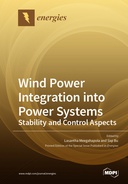Explore

Wind Power Integration into Power Systems: Stability and Control Aspects
0 Ungluers have
Faved this Work
Login to Fave
Power network operators are rapidly incorporating wind power generation into their power grids to meet the widely accepted carbon neutrality targets and facilitate the transition from conventional fossil-fuel energy sources to clean and low-carbon renewable energy sources. Complex stability issues, such as frequency, voltage, and oscillatory instability, are frequently reported in the power grids of many countries and regions (e.g., Germany, Denmark, Ireland, and South Australia) due to the substantially increased wind power generation. Control techniques, such as virtual/emulated inertia and damping controls, could be developed to address these stability issues, and additional devices, such as energy storage systems, can also be deployed to mitigate the adverse impact of high wind power generation on various system stability problems. Moreover, other wind power integration aspects, such as capacity planning and the short- and long-term forecasting of wind power generation, also require careful attention to ensure grid security and reliability. This book includes fourteen novel research articles published in this Energies Special Issue on Wind Power Integration into Power Systems: Stability and Control Aspects, with topics ranging from stability and control to system capacity planning and forecasting.
This book is included in DOAB.
Why read this book? Have your say.
You must be logged in to comment.
Rights Information
Are you the author or publisher of this work? If so, you can claim it as yours by registering as an Unglue.it rights holder.Downloads
This work has been downloaded 103 times via unglue.it ebook links.
- 103 - pdf (CC BY) at Unglue.it.
Keywords
- 3D aerodynamic model
- active power output
- artificial neural network (ANN)
- capacity allocation
- capacity configuration of SCES
- collaborative capacity planning
- control parameters
- correction modules
- cumulant-based method (CBM)
- DFIG
- distributed wind power (DWP)
- doubly fed induction generator
- doubly fed induction generator (DFIG)
- Economics, finance, business & management
- eigenvalue analysis
- electromechanical dynamics
- electromechanical loop correlation ratio (ELCR)
- Energy industries & utilities
- energy storage system (ESS)
- error following forget gate-based long short-term memory
- ES
- FCWG dynamic correlation ratio (FDCR)
- FCWG dynamics
- FORTRAN
- frequency control
- frequency response metrics
- full-converter wind
- fuzzy clustering
- fuzzy logic controller
- hybrid prediction model
- impedance modeling
- Industry & industrial studies
- inertial response
- kinetic energy
- linear sensitivity-based method (LSM)
- load frequency control (LFC)
- long short-term memory
- low inertia
- low voltage ride through (LVRT)
- model-based operational planning
- multi-model predictive control
- n/a
- optimization
- particle swarm optimization
- permanent magnet synchronous generator (PMSG)
- PSS/E
- quasi- electromechanical loop correlation ratio (QELCR)
- regional RoCoF
- renewable energy sources (RESs)
- Reynolds-averaged Navier–Stokes method
- rotor overspeed control
- scenario analysis
- strong interaction
- sub-synchronous resonance
- subsynchronous oscillation
- supercapacitor energy storage (SCES)
- Technology, engineering, agriculture
- Technology: general issues
- the center of inertia
- turbulence model
- ultra-short-term prediction
- variable-structure copula
- virtual inertia control
- virtual synchronous generator
- wavelet decomposition
- weak grids
- wind farm
- wind generation
- wind integration
- Wind power
- wind power generation
- wind turbine wake model
Links
DOI: 10.3390/books978-3-0365-1609-7Editions

